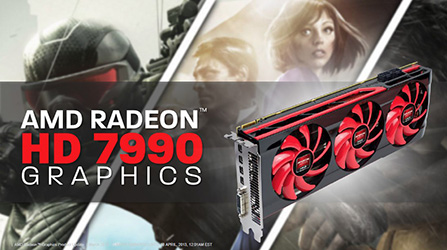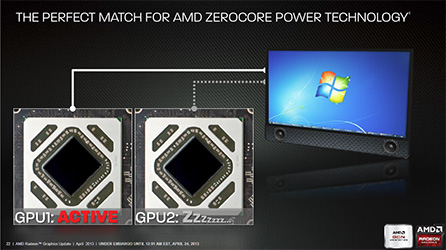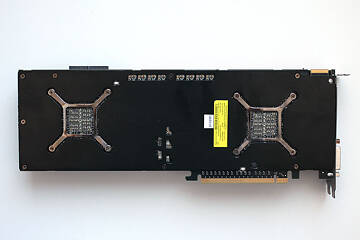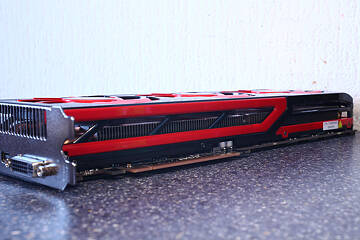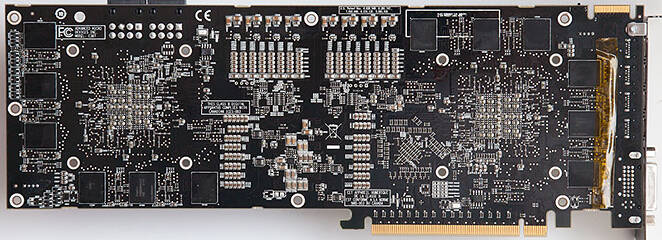 156
156
AMD Radeon HD 7990 6 GB Review
(156 Comments) »Introduction

Today, AMD launched its reference Radeon HD 7990 dual-GPU graphics card codenamed "Malta". The company's Radeon HD 7900 series preceded NVIDIA's high-end GTX 600 series by three months, yet NVIDIA was, with the launch of the GeForce GTX 690 close to a year ago, the first of the two to launch a dual-GPU graphics card based on its high-end silicon for this generation.
Part of the reason for things playing out as they did was NVIDIA's single-GPU flagship at the time, the GeForce GTX 680. Not only did it outperform AMD's Radeon HD 7970 GHz Edition, but it also made an attempt at a dual-GPU card by AMD futile. AMD's Radeon HD 7970 GHz Edition caught up with the GTX 680 in June, albeit at a significant power-draw cost that made a reference dual-GPU card all the more unfit for reference design treatment, since the GTX 690 showed near-perfect performance upscaling over the GTX 680 and exceptionally good power-draw. AMD's HD 7990, codenamed "New Zealand" on the company's roadmaps, was in jeopardy. The company did allow its board partners to come up with their own board designs that used a pair of HD 7970 GPUs, but those cards usually required three power connectors and triple-slot cooling solutions. AMD's 2012 clearly didn't end as well as the company had hoped for, at least in the extreme segment. By the turn of the year, AMD dropped hints that it hadn't given up on the reference HD 7990, adding that efforts to make this summer's high-end GPU segment interesting were well on their way.
The Radeon HD 7990 we have with us today is a far cry from the amp-guzzling "New Zealand" cards of 2012, so much so that AMD codenamed it "Malta." It makes do with a dual-slot cooling solution and draws power through two instead of three power connectors. It uses a pair of 28 nm "Tahiti" GPUs with all their physical components unlocked: the full complement of 2,048 stream processors, full 384-bit memory bus width, and clock speeds that don't look compromised. The core is clocked at a respectable 1.00 GHz, and its memory comes at 6.00 GHz. The card uses AMD's ZeroCore technology, which allows it to completely power down the card's second GPU outside of gaming.
Figuring out how the new HD 7990 "Malta" performs and whether its scaled down cooling and power connector requirements come at a cost will be a fascinating challenge. The card itself costs $1000 and will be available in stores within roughly two weeks.
| Radeon HD 7970 | HD 7970 GHz Ed. | GeForce GTX 680 | GeForce GTX 590 | GeForce GTX Titan | GeForce GTX 690 | Radeon HD 7990 | |
|---|---|---|---|---|---|---|---|
| Shader Units | 2048 | 2048 | 1536 | 2x 512 | 2688 | 2x 1536 | 2x 2048 |
| ROPs | 32 | 32 | 32 | 2x 48 | 48 | 2x 32 | 2x 32 |
| Graphics Processor | Tahiti | Tahiti | GK104 | 2x GF110 | GK110 | 2x GK104 | 2x Tahiti |
| Transistors | 4310M | 4310M | 3500M | 2x 3000M | 7100M | 2x 3500M | 2x 4310M |
| Memory Size | 3072 MB | 3072 MB | 2048 MB | 2x 1536 MB | 6144 MB | 2x 2048 MB | 2x 3072 MB |
| Memory Bus Width | 384 bit | 384 bit | 256 bit | 2x 384 bit | 384 bit | 2x 256 bit | 2x 384 bit |
| Core Clock | 925 MHz | 1050 MHz | 1006 MHz+ | 607 MHz | 837 MHz+ | 915 MHz+ | 1000 MHz |
| Memory Clock | 1375 MHz | 1500 MHz | 1502 MHz | 855 MHz | 1502 MHz | 1502 MHz | 1500 MHz |
| Price | $400 | $440 | $420 | $750 | $1000 | $1000 | $1000 |
The Card
The HD 7990 uses three large fans that cover pretty much the whole card. The card is 30.5 cm long and 11 cm high.
AMD's HD 7990 (top) is the same size as the HD 6990 (2nd from top). The HD 7970 is a bit shorter, but the GTX Titan (bottom) is the shortest of them all. This might be important to people building a powerful mini-PC gaming rig, since such a rig would have a limited amount of available space.
Installing the card requires two slots in your system.
Display connectivity options include one DVI port and four mini-DisplayPorts. You may use all outputs at the same time, so triple-monitor surround gaming is possible with one card.
The GPU also includes an HDMI sound device. It is HDMI 1.4a compatible, which includes HD audio and Blu-ray 3D movies support.
A single CrossFire connector is available, which would allow you to combine up to two HD 7990 cards in a multi-GPU configuration. The HD 7990 can also be CrossFired with any other Tahiti-based card: the HD 7970 GHz, HD 7970, HD 7950, or HD 7870 based on Tahiti LE.
Pictured above are the front and back, showing the disassembled board. High-res versions are also available (front, back). If you choose to use these images for voltmods, etc., please include a link back to this site, or let us post your article.
A Closer Look
As expected, AMD is using a relatively complex cooler that uses large copper heatsinks for GPU cooling. It also cools secondary components like the memory chips, voltage regulation circuitry and PCIe bridge chip.
The HD 7990 includes a blackplate, unlike the GTX 690 and GTX Titan. In this case, the backplate also provides cooling to the memory chips on the back of the card.
The card requires two 8-pin PCI-Express power cables for operation. This power configuration is good for up to 375 W of power draw.
A little green LED on the back of the card lights up when the second GPU is in ZeroCore/ULPS sleep mode. All three fans will still be running in that state, so the LEDs are the best way to check if ZeroCore is active.
Just like on other HD 7900 Series cards, the HD 7990 includes a dual-BIOS feature that toggles between the normal BIOS and a backup BIOS for both cards. This acts as an extra safeguard in case something goes wrong during a BIOS flash.
It's nice to see Volterra voltage controllers back on recent graphics card. The two Volterra VT1556 controllers handle one GPU each, providing monitoring features and software control via I2C.
The GDDR5 memory chips are made by Hynix and carry the model number H5GQ2H24AFR-R0C. They are specified to run at 1500 MHz (6000 MHz GDDR5 effective).
The PEX8747 48 lane PCI-Express Gen 3 Bridge chip is the latest in PLX's arsenal of PCIe bridge chip solutions. It is used to link the two GPUs and connects them to the rest of the system.
AMD's Tahiti graphics processor introduced the GCN shader architecture. It is also the first GPU to be produced on a 28 nm process at TSMC. The transistor count is 4.31 billion.
Test System
| Test System - VGA Rev. 27 | |
|---|---|
| Processor: | Intel Core i7-3770K @ 4.6 GHz (Ivy Bridge, 8192 KB Cache) |
| Motherboard: | ASUS Maximus V Gene Intel Z77 |
| Memory: | 2x 4096 MB Corsair Vengeance PC3-12800 DDR3 @ 1600 MHz 9-9-9-24 |
| Harddisk: | WD Caviar Blue WD5000AAKS 500 GB |
| Power Supply: | Antec HCP-1200 1200W |
| Software: | Windows 7 64-bit Service Pack 1 |
| Drivers: | NVIDIA: 314.22 WHQL ATI: Catalyst 13.3 Beta 3 HD 7990: 13.5 Beta 2. AMD recommended, latest |
| Display: | LG Flatron W3000H 30" 2560x1600 3x Hanns.G HL225DBB 21.5" 1920x1080 |
- All video card results were obtained on this exact system with exactly the same configuration.
- All games were set to their highest quality setting unless indicated otherwise.
- AA and AF are applied via in-game settings, not via the driver's control panel.
- 1280 x 800, 2x Anti-aliasing. Common resolution for most smaller flatscreens today (17" - 19"). A bit of eye candy turned on in the drivers.
- 1680 x 1050, 4x Anti-aliasing. Most common widescreen resolution on larger displays (19" - 22"). Very good looking driver graphics settings.
- 1920 x 1200, 4x Anti-aliasing. Typical widescreen resolution for large displays (22" - 26"). Very good looking driver graphics settings.
- 2560 x 1600, 4x Anti-aliasing. Highest possible resolution for commonly available displays (30"). Very good looking driver graphics settings.
- 5760 x 1080, 4x Anti-aliasing. Typical high-end gaming multi-monitor resolution. Very good looking driver graphics settings.
Our Patreon Silver Supporters can read articles in single-page format.
Apr 17th, 2025 02:48 EDT
change timezone
Latest GPU Drivers
New Forum Posts
- Windows 11 General Discussion (5986)
- Your PC ATM (35358)
- Need advice RAM for Asus Maximus hero z890 + core ultra 7 265k (34)
- Windows 11 fresh install to do list (38)
- RX 9000 series GPU Owners Club (338)
- Advice for DDR5 CU-DIMM 2 x 24gb 8400mhz (32)
- How to relubricate a fan and/or service a troublesome/noisy fan. (241)
- EVGA 3070ti hotspot is too high 107.7° (10)
- Will you buy a RTX 5090? (479)
- 5070 Ti power limit questions (42)
Popular Reviews
- G.SKILL Trident Z5 NEO RGB DDR5-6000 32 GB CL26 Review - AMD EXPO
- ASUS GeForce RTX 5060 Ti TUF OC 16 GB Review
- ASUS GeForce RTX 5080 TUF OC Review
- NVIDIA GeForce RTX 5060 Ti PCI-Express x8 Scaling
- DAREU A950 Wing Review
- Palit GeForce RTX 5060 Ti Infinity 3 16 GB Review
- ASUS GeForce RTX 5060 Ti Prime OC 16 GB Review
- Zotac GeForce RTX 5060 Ti AMP 16 GB Review
- The Last Of Us Part 2 Performance Benchmark Review - 30 GPUs Compared
- Sapphire Radeon RX 9070 XT Pulse Review
Controversial News Posts
- NVIDIA GeForce RTX 5060 Ti 16 GB SKU Likely Launching at $499, According to Supply Chain Leak (182)
- NVIDIA Sends MSRP Numbers to Partners: GeForce RTX 5060 Ti 8 GB at $379, RTX 5060 Ti 16 GB at $429 (127)
- Nintendo Confirms That Switch 2 Joy-Cons Will Not Utilize Hall Effect Stick Technology (105)
- Over 200,000 Sold Radeon RX 9070 and RX 9070 XT GPUs? AMD Says No Number was Given (100)
- Nintendo Switch 2 Launches June 5 at $449.99 with New Hardware and Games (99)
- NVIDIA Launches GeForce RTX 5060 Series, Beginning with RTX 5060 Ti This Week (92)
- Sony Increases the PS5 Pricing in EMEA and ANZ by Around 25 Percent (85)
- NVIDIA PhysX and Flow Made Fully Open-Source (77)
